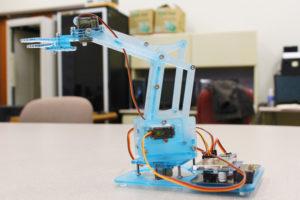 When Penn State University industrial engineering doctoral student Rakshith Badarinath was just a child, he already knew that his future would involve a career in manufacturing. With his eyes glued to Discovery Channel shows about car factories and the like, he eventually decided to pursue a bachelor’s degree in electrical engineering from the Siddagana Institute of Technology in India. Following that, Badarinath ended up attending Penn State for his graduate studies, which is where he was introduced to 3D printing technology for the first time in his life.
When Penn State University industrial engineering doctoral student Rakshith Badarinath was just a child, he already knew that his future would involve a career in manufacturing. With his eyes glued to Discovery Channel shows about car factories and the like, he eventually decided to pursue a bachelor’s degree in electrical engineering from the Siddagana Institute of Technology in India. Following that, Badarinath ended up attending Penn State for his graduate studies, which is where he was introduced to 3D printing technology for the first time in his life.
Ever since that fateful day, Badarinath has been working with faculty members from the Harold and Inge Marcus Department of Industrial and Manufacturing Engineering to convert old machines into 3D printers for the department’s Factory for Advanced Manufacturing Education (FAME) lab. Now, Badarinath has collaborated with Shu Shu Wang, who at the start of the project was working toward her master’s degree in industrial engineering, to build a robotic arm with the help of multiple 3D printing processes. The two innovators were connected by their advisor, Vittal Prabhu, and together, they worked to develop a robotic arm that would help improve manufacturing operations.

Penn State industrial engineering doctoral student Rakshith Badarinath and the 3D printed robotic arm. [Photo: Emily Chambers / Penn State News]
“We were focused on seeing if 3D printing would change the functionality of the arm,” Badarinath said. “Different processes can render different results. We wanted to know which was the most accurate and if inaccuracies would alter the end effect for the arm, which is extending and then gripping something.”
 Since the completion of their project, Wang has graduated with her master’s degree, while Badarinath still has three years left in his program, and is already off to another project. 3D printing technology has become a valuable asset for the production of robotic arms, whether they’re used for educational or assistive purposes. In the case of the two Penn State students, their 3D printed robotic arm project was just an enjoyable side project. Currently, Badarinath is working on a major personal project, which involves using industrial robotics for 3D printing technology. Discuss further in the 3D Printed Robotic Arm forum over at 3DPB.com.
Since the completion of their project, Wang has graduated with her master’s degree, while Badarinath still has three years left in his program, and is already off to another project. 3D printing technology has become a valuable asset for the production of robotic arms, whether they’re used for educational or assistive purposes. In the case of the two Penn State students, their 3D printed robotic arm project was just an enjoyable side project. Currently, Badarinath is working on a major personal project, which involves using industrial robotics for 3D printing technology. Discuss further in the 3D Printed Robotic Arm forum over at 3DPB.com.
Subscribe to Our Email Newsletter
Stay up-to-date on all the latest news from the 3D printing industry and receive information and offers from third party vendors.
You May Also Like
Gorilla Sports GE’s First 3D Printed Titanium Cast
How do you help a gorilla with a broken arm? Sounds like the start of a bad joke a zookeeper might tell, but it’s an actual dilemma recently faced by...
Nylon 3D Printed Parts Made More Functional with Coatings & Colors
Parts 3D printed from polyamide (PA, Nylon) 12 using powder bed fusion (PBF) are a mainstay in the additive manufacturing (AM) industry. While post-finishing processes have improved the porosity of...
$25M to Back Sintavia’s Largest Expansion of Metal 3D Printing Capacity Since 2019
Sintavia, the digital manufacturing company specializing in mission-critical parts for strategic sectors, announced a $25 million investment to increase its production capacity, the largest expansion to its operations since 2019....
Velo3D Initiates Public Offering in a Bid to Strengthen Financial Foundations and Drive Future Growth
Velo3D (NYSE: VLD) has been among a number of publicly traded 3D printing firms that have attempted to weather the current macroeconomic climate. After posting a challenging financial report for 2023,...































